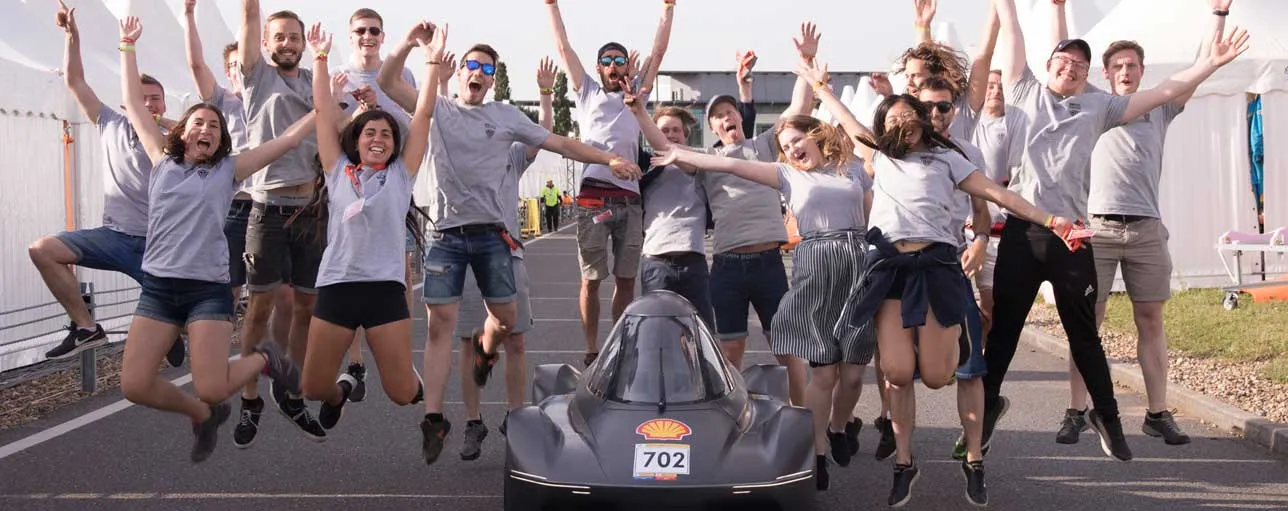Students from the Norwegian University of Science and Technology (NTNU) in Trondheim recently triumphed at the Shell Eco-marathon in London with an electric car developed by them and made in Norway. The team behind DNV GL Fuel Fighter won first prize for the best design and fifth prize for the most energy-efficient electric vehicle in the UrbanConcept Battery-Electric class.
While a Tesla model S can drive 5km per kWh, the Trondheim students' Fuel Fighter can cover 181km using the same amount of energy. That makes it thirty-six times as efficient!
If fully charged and with the same energy-efficiency, the Nissan Leaf – another very popular electric car in Norway - could drive from Trondheim to Oslo seven times without stopping to charge its battery.
The Shell Eco-marathon gathers students from all over Europe. The cars are developed by the students themselves as part of their studies at their respective universities. The Norwegian team from the NTNU participated this year with an entirely new car, developed in Trondheim with industrial designer Bård Eker as an important helper.
During the competition, the students are allowed four attempts at driving in the most energy-efficient way during 11 circuits of a 1,420-metre-long track, all within a maximum period of 39 minutes. DNV GL Fuel Fighter ended up in fifth place.
Of the five best teams in the Battery-Electric competition, DNV GL Fuel Fighter was the only one with an entirely new car. This meant the vehicle had not been tested to the same extent as its competitors, and the team experienced several technical problems after two attempts.
“The result is not bad, but based on the simulations done in advance we assumed a much better result, and might have won if everything had functioned as it was supposed to. It's a bit disappointing for this year's team when we know what the vehicle can do, but it gives next year's team a good chance, with more time to make final adjustments!" says Eirik Furuholmen, the proud DNV GL Fuel Fighter project manager.
The car not only did well on the track, it was also given the "Vehicle Design Award UrbanConcept". This is given to the car that is best developed for the competition, with a focus on technical areas, such as aerodynamics, structure and materials, as well as on aesthetics, ergonomics and environmental friendliness. The team is proud of winning the Design Award, as there were more than 40 vehicles in this class. "While you can be lucky or unlucky in the competition itself, this award is a clear measurement of how good the design of the vehicle and the team itself have been this year," adds Eirik Furuholmen.
The team started to plan the car as early as in 2017, but production did not start until 2019. Their goal was always to create a vehicle for the future, and the car is a result of close collaboration between NTNU students from various academic areas, such as design, product development, electronic system design and cybernetics.
"It's been exciting to see the project take shape from the start, and this is clearly a gang of clever students who have really managed to cooperate," confirms the car's godfather, Bård Eker. He says that although technical problems ruined their chances of a world record, they should be proud that they did so well with a vehicle built this season, and on top of this won the coveted design award. Irrespective of the result, they have learned an incredible amount that they can make use of in the future.
Kristina Dahlberg – the representative of DNV GL Fuel Fighter's main sponsor, DNV GL – has followed the team during the competition. She says she has seen true engineering skills, dedicated teamwork and a strong ability to solve problems. The team has shown a willingness to take risks, which is important in order to do better and learn from one's mistakes. "These are attributes that we in DNV GL value when recruiting and that are important when our own engineers are developing new technology," she says.
Facts
About the vehicle
- Weight: 72kg
- Length: 3.3 metres
- Breadth: 1.2 metres
- Height: 1.0 metres
- Projected frontal area: 0.75 m2
- Cd: 0.149 (air-resistance coefficient)
- One seat, room for luggage
- Two electric engines (Maxon RE50), one on each back wheel
About DNV GL Fuel Fighter
- A student organization started in 2008
- This year's team consists of 41 members
- The main sponsor for the past 10 years has been DNV GL
- The vehicles' godfather is Bård Eker
- https://www.fuelfighter.no/
About the Shell Eco-marathon
- Leading energy-efficiency competition
- Around 200 teams participate
- Students can compete in two classes; Prototype and UrbanConcept. Prototypes are vehicles that are driven lying down, since the focus is on aerodynamics and on beating records. The UrbanConcept involves vehicles that are like cars driven in towns, with requirements regarding the boot space, seated position, windscreen wipers, etc.
- In both classes, there are three competition categories, based on the fuel used - hydrogen, internal combustion engine (ICE) or battery electric.
- https://www.shell.com/make-the-future/shell-ecomarathon.html
